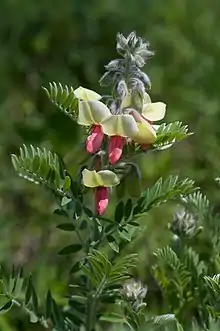Tephrosia virginiana
Tephrosia virginiana, also known as goat-rue, goat's rue,[2] catgut,[2] rabbit pea,[2] Virginia tephrosia,[2] hoary pea,[3] and devil's shoestring[4] is a perennial dicot in family Fabaceae. The plant is native to central and eastern North America.
| Tephrosia virginiana | |
|---|---|
 | |
| Scientific classification | |
| Kingdom: | Plantae |
| Clade: | Tracheophytes |
| Clade: | Angiosperms |
| Clade: | Eudicots |
| Clade: | Rosids |
| Order: | Fabales |
| Family: | Fabaceae |
| Subfamily: | Faboideae |
| Genus: | Tephrosia |
| Species: | T. virginiana |
| Binomial name | |
| Tephrosia virginiana | |
| Synonyms[1] | |
| |
Description
This subshrub is low and bushy, growing to 60 centimetres (2 ft), but more often shorter. Its leaves are alternate and compound, usually with 8 to 15 pairs of narrow, oblong leaflets.[3] Soft white hairs on the leaves and the stem give them a silvery, or hoary, appearance.[5]
The flowers look similar to other flowers in the pea family and are bi-colored, with a pale yellow or cream upper petal (the standard), and pink petals on the bottom (the keel and wings).[4] The flowers are grouped into clusters at the top of the stems and bloom from May to August. The seed pods that form after the flowers bloom are small, approximately 5 centimetres (2 in) long.[3]
The roots are long and stringy, which is probably the source of the common names catgut and devil's shoestrings.[4]
Distribution and habitat
This plant prefers acidic soils, in part to full sun.[6] It grows throughout the Midwest, New England and southeastern United States.[7] Not easy to propagate because of the relationship it has with the acid soil it needs,[8] this plant can be found in sand savannas, open woods and glades, prairies and rocky soils.[3]
Toxicity
All tissues of this plant are toxic (containing rotenone), and should not be eaten by people or livestock. Crushed stems were previously used as a fish poison.[9]
References
- "The Plant List: A Working List of All Plant Species". Retrieved 26 July 2014.
- "Tephrosia virginiana". Germplasm Resources Information Network. Agricultural Research Service, United States Department of Agriculture. Retrieved 14 January 2018.
- Denison, Edgar (2017). Missouri Wildflowers (Sixth ed.). Conservation Commission of the State of Missouri. p. 64. ISBN 978-1-887247-59-7.
- "Lady Bird Johnson Wildflower Center - The University of Texas at Austin". www.wildflower.org.
- "Tephrosia virginiana (Catgut, Devil's Shoestring, Goat's Rue, Hoary Pea, North American Turkey Pea, Virginia Goat's Rue, Virginia Tephrosia, Wild Sweetpea) | North Carolina Extension Gardener Plant Toolbox". plants.ces.ncsu.edu.
- "Tephrosia virginiana - Plant Finder". www.missouribotanicalgarden.org.
- USDA Plants Database
- "Goat's Rue". www.fs.usda.gov.
- Zhang, Peiwen; Qin, Deqiang; Chen, Jianjun; Zhang, Zhixiang (21 October 2020). "Plants in the Genus Tephrosia: Valuable Resources for Botanical Insecticides". Insects. 11 (10): 721. doi:10.3390/insects11100721. PMC 7589259. PMID 33096762.
- Peterson, Lee. (1977) A Field Guide to Edible Wild Plants of Eastern and Central North America. Houghton Mifflin Company, Boston. p. 82.
